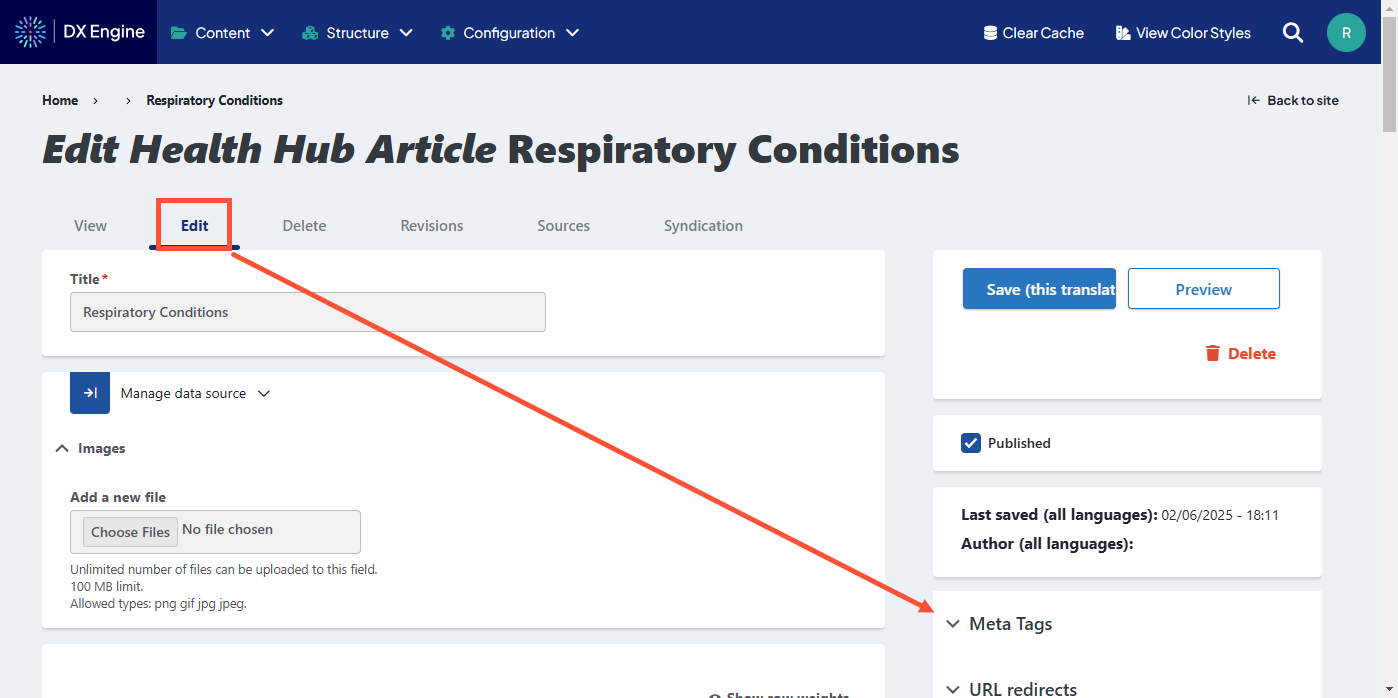Overview
Meta tags are meta data applied to a page that change how the page behaves or appears in other contexts outside of HealthHub, such as:
- What displays in the tab of the web browser
- What appears in search engine results that display a summary of a page
- Whether or not a page can be indexed by search engines (outside of HealthHub itself)
Meta tags differ from Taxonomy, which is used to categorize content for use and searchability within HealthHub. Meta tags are global standardized fields that interact with searching, browsing, and interface items outside of HealthHub.
Where to access meta tags
To access the meta tags on any individual piece of content: first navigate to the content, then click Edit to access the Edit screen. The Meta Tags section can be expanded in the right sidebar:

Available meta tags
Basic tags
- Page title: The text to display in the title bar of a visitor's web browser when they view this page. This meta tag may also be used as the title of the page when a visitor bookmarks or favorites the page, or as the page title in a search engine result. It is common to append 'HealthHub Help Center' to the end of this, so the site's name is automatically added.We recommend that the title is no greater than 55 - 65 characters long, including spaces.
- Description: A brief summary of the page's content that is a maximum of 160 characters in length. The description meta tag may be used by search engines to display a snippet about the page in search results.
- Abstract: A brief summary of the page's content, preferably 150 characters or less. Whereas the description meta tag may be used by search engines to display a snippet about the page in search results, the abstract tag may be used to archive a summary about the page. This meta tag is no longer supported by major search engines.
- Keywords: A comma-separated list of keywords about the page. This meta tag is no longer supported by most search engines.
Basic tags
These tags have specific, uncommon use cases. Unless you are sure you need to use any of these tags, we recommend leaving these options as blank or default values.
- Geographical place name: A location's formal name.
- ICBM: Geo-spatial information in 'latitude, longitude' format, e.g. '50.167958, -97.133185'; see Wikipedia for details.
- Geographical position: Another version of geo-spatial information in 'latitude, longitude' format, e.g. '50.167958, -97.133185'; see Wikipedia for details.
- Geographical region: A location's two-letter international country code, with an optional two-letter region, e.g., 'US-NH' for New Hampshire in the USA.
- Shortlink URL: A brief URL, often created by a URL shortening service.
- Canonical URL: A link to the preferred page location or URL of the content of this page, to help eliminate duplicate content penalties from search engines.
- Robots: Provides search engines with specific directions for what to do when this page is indexed.
- index: Allow search engines to index this page (assumed if no indexing options are checked).
- follow: Allow search engines to follow links on this page (assumed if no follow options are checked).
- noindex: Prevents search engines (except for HealthHub) from indexing this page (selected by default).
- nofollow: Prevents search engines from following links on this page (selected by default).
- noarchive: Prevents cached copies of this page from appearing in search results.
- nosnippet: Prevents descriptions from appearing in search results, and prevents page caching.
- noimageindex: Prevent search engines from indexing images on this page.
- notranslate: Prevent search engines from offering to translate this page in search results.
- Max Snippet: Set a maximum number of characters used as a snippet for this search result. "0" equals "nosnippet". "-1" will let the search engine decide the most effective length.
- Max Video Preview: Set a maximum of number seconds for a video snippet of videos on this page in search results. "0" will use a static a image. "-1" means there is no limit.
- Max Image Preview: Set the maximum size of an image preview for this page in a search results. Possible values are None, Standard, or Large.
- Unavailable after date: Hide the page from search results after the specified date.
- Content Language: Deprecated. Used to define this page's language code. Format can be the two letter language code (e.g. "de" for German), or the two letter code with a dash and the two letter ISO country code (e.g. "de-AT" for German in Austria). Still used by Bing.
- News Keywords: A comma-separated list of keywords about the page. This meta tag is used as an indicator in Google News.
- Previous page URL: Used for paginated content by providing URL with rel='prev' link.
- Next page URL: Used for paginated content by providing URL with rel='next' link.
- Standout: Highlight standout journalism on the web, especially for breaking news; used as an indicator in Google News. Warning: This is only to be used a maximum of 7 times per calendar week.
- Author: Define the author of a page.
- Generator: Describes the name and version number of the software or publishing tool used to create the page.
- Original source: Used to indicate the URL that broke the story, and can link to either an internal URL or an external source. If the full URL is not known it is acceptable to use a partial URL or just the domain name.
- Image: An image associated with this page, for use as a thumbnail in social networks and other services. This will be able to extract the URL from an image field if the field is configured properly.
- Rights: Details about intellectual property, such as copyright or trademarks; does not automatically protect the site's content or intellectual property.
- Refresh: The number of seconds to wait before refreshing the page. May also force redirect to another page using the format '5; url=https://example.com/', which would be triggered after five seconds.
- Referrer policy: Indicate to search engines and other page scrapers whether or not links should be followed. See the W3C specifications for further details. Note: this serves the same purpose as the HTTP header by the same name.
- Set cookie: Sets a cookie on the visitor's browser. Can be in either NAME=VALUE format, or a more verbose format including the path and expiration date; see the link for full details on the syntax.
- Google: This meta tag communicates with Google. There are currently two directives supported: 'nositelinkssearchbox' to not to show the sitelinks search box, and 'notranslate' to ask Google not to offer a translation of the page. Both options may be added, just separate them with a comma. See meta tags that Google understands for further details.
- Rating: Used to rate content for audience appropriateness. This tag has little known influence on search engine rankings, but can be used by browsers, browser extensions, and apps. The most common options are general, mature, restricted, 14 years, safe for kids. If you follow the RTA Documentation you should enter RTA-5042-1996-1400-1577-RTA
- Revisit After: Tell search engines when to index the page again. Very few search engines support this tag, it is more useful to use an XML Sitemap file.
- Cache control: Used to control whether a browser caches a specific page locally. Not commonly used. Should be used in conjunction with the Pragma meta tag.
- Expires: Control when the browser's internal cache of the current page should expire. The date must to be an RFC-1123-compliant date string that is represented in Greenwich Mean Time (GMT), e.g. 'Thu, 01 Sep 2016 00:12:56 GMT'. Set to '0' to stop the page being cached entirely.
- Pragma: Used to control whether a browser caches a specific page locally. Not commonly used. Should be used in conjunction with the Cache-Control meta tag.
In addition, there are advanced meta tags available in the following categories:
- Open Graph: The Open Graph meta tags are used to control how Facebook, Pinterest, LinkedIn and other social networking sites interpret the site's content.
The Facebook Sharing Debugger lets you preview how your content will look when it's shared to Facebook and debug any issues with your Open Graph tags. - Twitter (X) cards: A set of meta tags specially for controlling the summaries displayed when content is shared on X (formerly known as Twitter).
- Site verification: These meta tags are used to confirm site ownership for search engines and other services.

